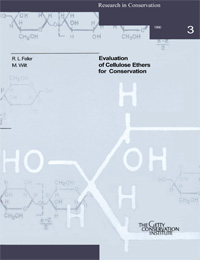This report is the result of a three-year research program. It describes the chemical character of cellulose ethers as a general class of polymers and establishes an approximate ranking of the relative stability of each generic chemical subclass. Ranking the thermal stability of the polymers with respect to color change and loss in degree of polymerization led to the conclusion that as generic chemical classes, methylcellulose and carboxymethylcellulose appear to be the most stable of the cellulose ethers. Water-soluble ethylhydroxyethylcellulose apparently also possesses good stability. Of questionable long-term stability are hydroxyethylcellulose and hydroxy- propylcellulose. Ethylcellulose and organic-soluble ethylhydroxyethylcellulose proved to be of poor stability, potentially undergoing marked changes in twenty years or less under normal museum conditions.
An important additional conclusion reached here, as well as in an earlier investigation, is that considerable variations in stability can occur within a generic chemical class from differences in the basic raw material, a natural product from plants, which is not a uniform, manufactured, chemical substance. Further variations can exist due to different manufacturing processes or commercial sources. Hence, commercial products must be evaluated individually to determine the most stable of a given generic type. Nonetheless, the authors believe the conclusions expressed here to be valid with regard to the relative stability of the generic chemical classes of cellulose ethers.
How to Cite this Work
Feller, Robert L., and M. Wilt. 1990. Evaluation of Cellulose Ethers for Conservation. Research in Conservation 3. Marina del Rey, CA: Getty Conservation Institute. http://hdl.handle.net/10020/gci_pubs/cellulose_ethers
